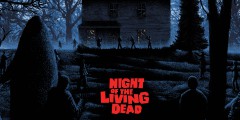Algorithmic Flows: Binge-watching and the Televisual
January 8, 2016
Binge-watching, the practice of watching multiple (if not every) episode of a television series in one go, is seemingly becoming the de facto way to watch episodic content. ‘Binge-watch’ was declared the 2015 word of the year by Collins dictionaries, a sign that the concept has, thanks to the proliferation of online viewing services like …
We meet again, at last
December 15, 2015
How do you make a familiar thing new? One way to do it, as Ezra Pound knew, is to invoke a long-forgotten tradition and adapt it to the pressures of the moment. For George Lucas – the George Lucas of the Star Wars prequels, at any rate – making new means making shiny. J. J. …
The Hunger Games: Mockingjay – Part 2: Katniss and the Ideal Rebel
November 18, 2015
Ibitsam Ahmed from our School of Politics and International Relations reflects on Katniss Everdeen and her role as the ideal rebel. In The Hunger Games quadrilogy, Katniss Everdeen embodies the persona of the Mockingjay, the symbolic Girl on Fire at the heart of the revolution against the oppressive Capitol. Starting off as the unlikely and …
Designer dragons and transgenic triffids
November 17, 2015
Sean May from our School of Biosciences discussed the genetic imagination in his recent Popular Culture lecture. How might we build a dragon? Or dinosaur? Or triffid? First we need to set some design parameters: Feathered serpents are found in the myths, religions and heraldry of all populated continents: From Quetzalcoatl in the Aztec west; through …
Science fiction vs. science fact
November 11, 2015
Dr Catrin Rutland from our School of Veterinary Medicine and Science introduces the lecture she’ll be giving this week as part of the Popular Culture series. In the 1950’s a new science was born, yet scientists and the literature had long been fascinated with what we now call ‘Genetics’. Long before the term genetics existed, writers …
Zombie Genomics – Sean on the Dead
October 30, 2015
Sean May from our School of Biosciences discussed the science of zombies as part of the Popular Culture Lecture Series earlier this year. I’m an unashamed slow-zombie fanboy (fast-zombies are just a trivial problem in viral epidemiology IMHO); and have pondered zombie biology for decades. This was an opportunity to really get my teeth into …
Do you like scary movies?
October 26, 2015
Keith Bound from the School of Cultures, languages and Area Studies discussed cinematic suspense and his Terror and Tension film experiment earlier this year. Susan Smith’s suspense narrative model defines four forms of suspense: Direct: we see the film in the first person – as if we are the character in the film. Shared: when …
James Bond’s ghosts
Dr Nathan Waddell from our School of English introduces the first session of Popular Culture Lecture Series II. Every hero has a spectre. For every Bond there’s a Blofeld. For every Katniss Everdeen a Coriolanus Snow. We value heroes because of their villains. Blofeld’s machinations make Bond more daring. Snow’s intolerance makes more charitable the future …
Four-Dimensional Wanderings
October 20, 2015
In honour of Back to the Future day, Dr Peter Millington from our School of Physics explores what science really has to say about time travel. Our everyday experience leads us to believe that time is immutable; that there is some universal clock whose ticking we are powerless to stop. Our lives, unlike Benjamin Button’s, …
Which one’s your Pop culture?
In honour of Back to the Future Day, Dr Nathan Waddell from our School of English has re-watched all three films in the trilogy and needs to talk to you about temporal shifts. Great Scott! You’ve got to come back with me. BACK TO THE FUTURE! Back to the 2015 of Back to the Future …










